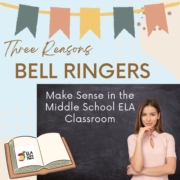Organizational Tips for Teachers to Save Your Sanity
As a teacher, you know that organization is not just important. It is essential! We have two organizational tips for teachers to save your sanity. We have used these for years, and they work!
Our first organizational tip for teachers is to color code supplies in your classroom.
We color code just about everything in our classrooms, and it starts with folders that our students use for bell work. If you don’t use bell work, it is a lifesaver when it comes to classroom management, check out our blog post or podcast episode five where we talk about the bell work we use.
In our middle school ELA classrooms, we use two bell ringers, Core Chomp and Daily Grammar Minutes. As our students enter our classrooms, they pick up their folder that houses their bell work papers. We don’t let our students take this work out of the classroom because we have found that this prevents issues with students losing them or forgetting them, and this is where our first color coding comes in to play. We color code these folders, using green for first period and red for last period because green means go and red means stop, of course. For our other classes, we use blue or yellow. Organizing these folders by color makes it visually simple to grab a class set and give out the right ones, espeically if you teach multiple classes in a day. Using primary colors is what works for us because those colors are easy to find.
In addition to our students’ color-coded folders, we have our own teacher color-coded folders for each class too. In our green teacher folders, we keep the bell work that we use to go over it for first period daily as well as a copy of the key and any other papers needed that day for that period.
Our classroom labels are color coded as well. For example, drawers used for students to turn papers in are labeled with green, blue, yellow and red. In Google Drive, a color-coded folder is used for each class. This is great for saving emails, spreadsheets, or anything related to a student in a certain class.
Even paper clips can become a color-coded organizational tool. If the office gives you papers that need to be given out first period, grab a green paper clip. You can use a paper clip or a magnetic bookmark to mark the pages in your class novels. If you are like us, each period does not get to the same place in the novel that you’re reading. So, for example, if first period ends on page 20, and third period ends on page 25, mark those pages with a green clip for first and a yellow one for third! The next day, you know where to begin.
Color coding works!
Our second organizational tip for teachers is to use Popsicle (craft) Sticks, color-coded of course!
If you are not using popsicle sticks in your classroom, trust us on this, you should! They are simple and effective. There are a lot of digital options available for calling on students, and we have tried those, but we always return to our faithful popsicle sticks. These sticks are super simple to use and work for so many things you do daily in the classroom. You can find a pack of multicolored Popsicle sticks at Walmart or a craft store. Simply write each students name with a Sharpie on both sides of the sticks, and you’re set for the year. Along with everythibng else, we color code our sticks as well. First period gets the green sticks. Last period gets the red ones, and the classes in between are assigned blue and yellow. When we are ready to go over bellwork in first period, we grab the green sticks, and begin calling on students.
Popsicle sticks can be used in many ways. In addition to calling on students, here are a few more ways to use them.
- For rewards, you can pick a popsicle stick to give a quick treat to a student who is on task. This means a lot to the kids, and it is fast and random. It’s a great motivational tool for keeping kids focused and on task. Also, if you are working through a lesson, you could ask a question and say “Okay, I’m going to pull a stick. If you get this right, you’ll earn a high-five or a piece of candy.”
- Use Popsicle sticks when you need a student to run an errand. If you need a kid to go to the office, of course they all will want to go. Pulling a stick makes the choice random and quick.
- Use popsicle sticks to call on students whenever you want them to answer. We use the sticks everyday as we go over the answers for bell work, but we also use them throughout the class for other questions. This helps us to call on everyone, not just students with their hands up. Calling on kids in this way keeps students engaged; they never know when it will be “their turn” to provide an answer.
- Use sticks to keep up with absences. As we use the sticks to call on students for bell work, we keep a separate “pile” for anyone who is absent. This is a visual cue for us to take attendance and to sort any work that will need to be made-up.
- Use popsicle sticks to group students. Sometimes, you have to plan your groups ahead of time strategically and decide who needs to be with who. But there are other times you just want to quickly group students. So if you need to put students in groups really fast, you can say, “All right, we’re going to use popsicle sticks. Stop telling me who you want to be with because I’m in charge of this.” Then, just pull sticks and lay them out to create groups. With a glance, you can switch them around as needed, and your groups are done! It’s a super easy and fast way to put kids in groups.
- Use the sticks to tell students where to go in the classroom. We have “special spots” that students enjoy using. For example, Shannon has an area that has carpet and cool little chairs where students all want to do group work. So to make it fair, she says, “Alright, I’m pulling a stick, and that person’s group gets to work on the carpet today.”
Popsicle sticks just work, and color coding them makes things easy!







